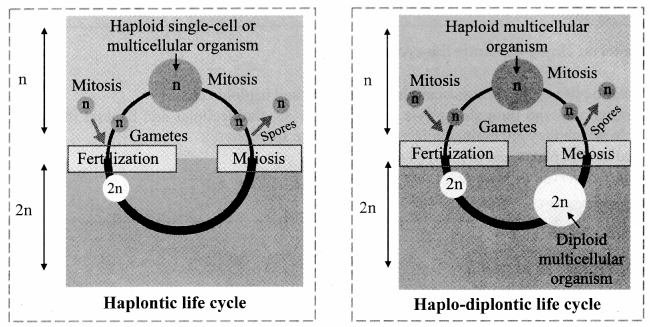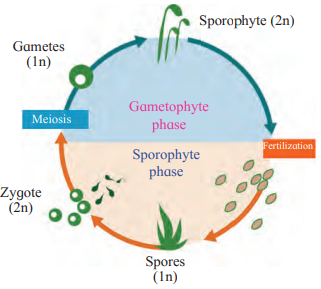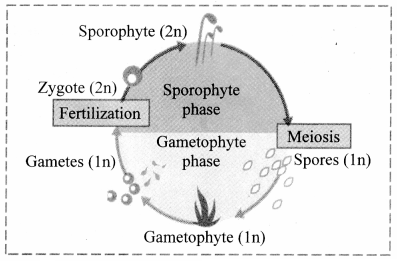Kingdom Plantae – Solutions
1. Choose correct option
A. Which is the dominant phase in Pteridophytes?
a. Capsule b. Gametophyte
c. Sporophyte d. Embryo
Answer: c. Sporophyte
- Explanation: In Pteridophytes, the sporophyte is the dominant, diploid, autotrophic, and independent phase, differentiated into root, stem, and leaves.
B. The tallest living gymnosperm among the following is ……….
a. Sequoia sempervirens
b. Taxodium mucronatum
c. Zamia pygmaea
d. Ginkgo biloba
Answer: a. Sequoia sempervirens
- Explanation: The document states that Sequoia sempervirens (coast redwood of California) is the tallest living plant, reaching about 366 feet.
C. In Bryophytes ……….
a. Sporophyte and gametophyte generations are independent
b. Sporophyte is partially dependent upon gametophyte
c. Gametophyte is dependent upon Sporophyte
d. Inconspicuous gametophyte is present
Answer: b. Sporophyte is partially dependent upon gametophyte
- Explanation: The document explains that in Bryophytes, the sporophyte is short-lived, multicellular, and depends partially or totally on the gametophyte for nutrition and anchorage.
D. A characteristic of Angiosperm is ………
a. Collateral vascular bundles
b. Radial vascular bundles
c. Seed formation
d. Double fertilization
Answer: d. Double fertilization
- Explanation: Double fertilization is a unique feature of Angiosperms, as noted in the document, where one sperm fertilizes the egg to form a zygote, and another fuses with polar nuclei to form the endosperm.
E. Angiosperms differ from Gymnosperms in having ……….
a. Vessels in wood
b. Autotrophic Mode of nutrition
c. Siphonogamy
d. Enclosed seed
Answer: d. Enclosed seed
- Explanation: The document highlights that Angiosperms have seeds enclosed within a fruit (ovary), unlike Gymnosperms, which produce naked seeds.
2. How you place the pea, jawar and fern at its proper systematic position? Draw a flow chart of each.
Answer:
3. Complete the following table
Answer:
| Groups of algae | Chlorophyceae | Phaeophyccac | Rhodophyceae |
| 1. Stored food | Starch | Mannitol, laminarin | Floridean starch |
| 2. Cell wall | Cellulose | Cellulose and algin | Cellulose, pectin |
| 3. Major pigments | Chl-a, b | Chl-a, c, fucoxanthin | Chl-a, d and phycoerythrin |
4. Differentiate between Dicotyledonae and Monocotyledonae based on the following characters
a. Type of roots b. Venation in the leaves c. Symmetry of flower
| Character | Dicotyledonae | Monocotyledonae |
|---|---|---|
| a. Type of roots | Tap root system | Adventitious root system |
| b. Venation in leaves | Reticulate venation | Parallel venation |
| c. Symmetry of flower | Tetra- or pentamerous symmetry | Generally trimerous symmetry |
Explanation:
- Type of roots: Dicots have a primary tap root with lateral branches, while monocots have a fibrous, adventitious root system.
- Venation in leaves: Dicot leaves show a net-like (reticulate) pattern, whereas monocot leaves have parallel veins.
- Symmetry of flower: Dicot flowers typically have four or five parts (tetra- or pentamerous), while monocot flowers usually have three parts (trimerous).
5. Answer the following questions
A. We observe that land becomes barren soon after monsoon. But in the next monsoon, it flourishes again with varieties we observed in the season earlier. How do you think it takes place?
Answer: This phenomenon occurs due to the life cycle and survival strategies of plants, particularly Bryophytes and Pteridophytes. During the monsoon, moist conditions favor the growth of these plants, which reproduce via spores or gametes requiring water for fertilization. After the monsoon, the land dries, and the plants’ gametophytes or sporophytes may die or become dormant. However, their spores or reproductive structures remain viable in the soil. When the next monsoon arrives, these spores germinate, and favorable conditions allow the plants to flourish again, repeating the cycle. The document highlights that Bryophytes, called amphibious plants, need water for fertilization, and their spores enable survival through dry periods .
B. Fern is a vascular plant. Yet it is not considered a Phanerogam. Why?
Answer: Ferns are vascular plants with true roots, stems, and leaves, possessing xylem and phloem. However, they are not considered Phanerogams because they do not produce seeds. Ferns belong to the Cryptogamae, reproducing via spores and lacking flowers and seeds. Phanerogams, in contrast, are seed-producing plants (Gymnosperms and Angiosperms) with visible reproductive structures. Thus, despite being vascular, ferns’ spore-based reproduction excludes them from Phanerogams.
C. Chlamydomonas is microscopic, whereas Sargassum is macroscopic, both are algae. Which characters of these plants include them in one group?
Answer: Chlamydomonas and Sargassum are both algae (division Thallophyta) due to the following shared characteristics:
- Thalloid plant body: Both lack differentiation into true roots, stems, and leaves.
- Aquatic habitat: Both are primarily aquatic (Chlamydomonas in freshwater, Sargassum in marine environments).
- Photosynthetic pigments: Both contain chlorophyll for photosynthesis, though Sargassum has additional pigments like fucoxanthin.
- Cell wall composition: Both have cell walls with polysaccharides like cellulose or proteins.
- Reproduction: Both exhibit vegetative, asexual, and sexual reproduction with alternation of generations.
- These features unify them as algae despite their size difference.
6. Girth of a Maize plant does not increase over a period of time. Justify.
Answer: Maize (Zea mays) is a Monocotyledonae, which typically lacks secondary growth. Secondary growth, responsible for increasing girth, occurs due to the activity of cambium, which forms additional xylem and phloem. In monocots, vascular bundles are closed (lacking cambium), and secondary growth is absent except in rare cases. Therefore, the girth of a maize plant does not increase over time as it relies on primary growth for development.
7. Radha observed a plant in the rainy season on the compound wall of her school. The plant did not have true roots but root-like structures were present. To which group may the plant belong?
Answer: The plant likely belongs to Bryophyta. Bryophytes, such as liverworts or mosses, lack true roots but have root-like structures called rhizoids that absorb water and anchor the plant. These plants thrive in moist, shady places like compound walls during the rainy season and are called amphibious plants due to their dependence on water for fertilization. The absence of true roots and the presence of rhizoids strongly suggest Bryophyta.
8. Draw neat labelled diagrams
A. Spirogyra
B. Chlamydomonas
C. Funaria
D. Nephrolepis
E. Haplontic and haplodiplontic life cycle
9. Identify the plant groups on the basis of following features.
A. Seed producing plants
Answer: Phanerogamae (Gymnospermae and Angiospermae)
- Explanation: That Phanerogamae are seed-producing plants with visible reproductive structures. This includes Gymnosperms (naked seeds, e.g., Cycas, Pinus) and Angiosperms (enclosed seeds, e.g., Helianthus, Zea mays).
B. Spore producing plants
Answer: Cryptogamae (Thallophyta, Bryophyta, Pteridophyta)
- Explanation: Cryptogamae are spore-producing plants that do not produce seeds or flowers, reproducing sexually by gametes with concealed sex organs. This includes Thallophyta (algae, e.g., Chlamydomonas), Bryophyta (mosses, e.g., Funaria), and Pteridophyta (ferns, e.g., Nephrolepis).
C. Plant body undifferenciated into Root, Stem and leaves
Answer: Thallophyta (Algae)
- Explanation: Thallophyta have a thalloid plant body, which is undifferentiated into roots, stems, and leaves. They may be unicellular (e.g., Chlorella), filamentous (e.g., Spirogyra), or macroscopic (e.g., Sargassum).
D. Plant need water for fertilization
Answer: Cryptogamae (Thallophyta, Bryophyta, Pteridophyta)
- Explanation: Cryptogams require water for fertilization as their gametes (e.g., sperm) need a moist environment to reach the egg. This is particularly emphasized for Bryophytes, called amphibious plants due to their dependence on water for fertilization, and also applies to algae and Pteridophytes.
E. First vascular plants
Answer: Pteridophyta
- Explanation: Pteridophytes are described as the first vascular and true land plants, with a primitive conducting system (xylem and phloem) and true roots, stems, and leaves. They are the only Cryptogams with vascular tissues.
10. Observe the following diagram. Correct it and write the information in your words.
Answer:










Leave a Reply